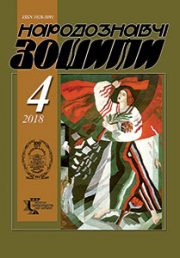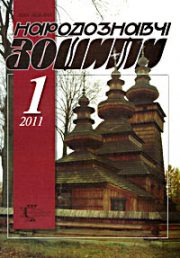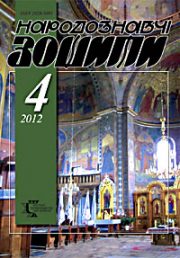The Ethnology Notebooks. 2021. № 5 (161), 1273—
UDK 398.3(477.87):159.922.4
DOI https://doi.org/10.15407/nz2021.05.1273
ETHNOPSYCHOLOGICAL SPECIFICS OF THE IMAGE OF POVITRULYA IN UKRAINIAN FAIRY TALES AND OLD STORIES
TYKHOVSKA Oksana
- ORCID ID: https://orcid.org/0000-0003-4663-5960
- D. Sc. in Philology, SHEE «Uzhhorod National University»,
- Professor of the Ukrainian Literature Department,
- 3, Narodna Square, 88000,Uzhhorod, Ukraine,
- Contacts: e-mail: oksana.tykhovska@uzhnu.edu.ua
Abstract. The purpose of the article is to analyze the semantics of the image of povitrulya in different genres of Ukrainian folklore. The object of the research is Ukrainian fairy tales, beliefs and old stories, the heroine of which is povitrulya, as well as folklore and ethnographic research of Fedir Potushnyak «Demons in folk beliefs» (1940). The subject of research is ethno-psychological specifics of the image of povitrulya. Methods of the research are psychoanalytic, structural-semantic, structural-typological, genetic.
Povitrulyas differ from other female mythological characters (mavkas, mermaids) because they can fly and have power over the winds. She is an ambivalent image. It is believed that povitrulyas treat boys with an unclean conscience with contempt and tear them to pieces. In some mythological stories of Transcarpathia, the image of friendly povitrulyas sometimes appears. They are projections of the light goddess, shepherds fall in love with them and stay with them in the mountains.
Legends, old stories, and fairy tales model different situations of meeting their main character with a povitrulya, which appears as a projection of the archetype of Anima. In fairy tales, a povitrulya can become a man’s wife if he steals her wings or clothes («Wife-povitrulya», «Sopilkar Marco and povitrulya», «Woman who has wings»). The wings (clothes) of the povitrulya symbolize its belonging to the celestial sphere, to the element of air, and they are also a magical shell that makes the povitrulya invisible. At the same time, the wings of the povitrulya are a metaphorical mask that determines the dominance of the divine nature in a woman’s soul, reveals her spiritual qualities. Wings dropping symbolizes the approaching of the povitrulya to the image of an ordinary woman and presupposes the possibility of her obedience to another’s will (husband’s wishes). The hero of fairy tales loses a wife-povitrulya for a short period of time, but later regains her back, and in old stories with a similar motif, the povitrulya disappears forever from the life of her husband. In the fairy tale «The Bridegroom-Snake and the Bride-Frog» the povitrulya appears as a minor character. She helps the main character to get what he wants. In the fairy tale «About Pharmudz-Ivan» the image of the povitrulya acquires distinctly demonic characteristic, she kidnaps the bride of the main character and thus forces him to go through a series of difficult trials. In the stories «Polonyna Kamin», «Bisytsia» the povitrulya tries to make the hero the object of her passion, and later the unrealized love scenario makes the young man extremely unhappy, he is no longer able to fall in love.
Keywords: mythology, old story, povitrulya, fairy tale, psychoanalysis, folklore of Transcarpathia.
Received 7.10.2021
REFERENCES
- Krymskiy, S. (2006). Archetypes of Ukrainian mentality. Problems of the theory of mentality (Pp. 273—299). Kyiv: Naukova dumka [in Ukrainian].
- Yatchenko, V. (2009). Transformation of ideas about death in Carpathian folklore as an indicator of human existential aspirations. Scientific bulletin of National University of life and environmental science of Ukraine, 137, 195—201 [in Ukrainian].
- Potushnyak, F. (1940, 30 august). Demons in folk beliefs. Ruskaya Pravda, 181, 3 [in Ukrainian].
- (1955). Transcarpathian tales of Andriy Kalyna. Uzhhotod: Transcarpathian regional publish house [in Ukrainian].
- (1972). Legends of our land. Uzhhorod: Carpathians [in Ukrainian].
- (2007). Franz fon, M.-L. Archetypical patterns in fairy tales. Moscow: Klass [in Russian].
- (1972). Twelve brothers. Transcarpathian tales of Andriy Kalyna. Uzhhorod: Carpathians [in Ukrainian].
- (1973). Fairy tales of Bukovyna. Uzhhorod: Carpathians [in Ukrainian].
- (2003). How it was a long time ago: Legends, retellings, stories, tales and parables of Transcarpathia in the records of Ivan Senko. Uzhhorod: Transcarpathia [in Ukrainian].
- (1988). Magic bag. Ukrainian folk tales, parables, legends, retellings, songs and proverbs recorded by M.I. Shoplyak. Uzhhorod: Carpathians [in Ukrainian].
- Maksumovych, M. (2002). Days and months of the Ukrainian peasant. Kyiv: Oberegy [in Ukrainian].
- (1965). Tales of green mountains: Transcarpathian tales of Mykhailo Halytsia. Uzhhorod: Carpathians [in Ukrainian].







